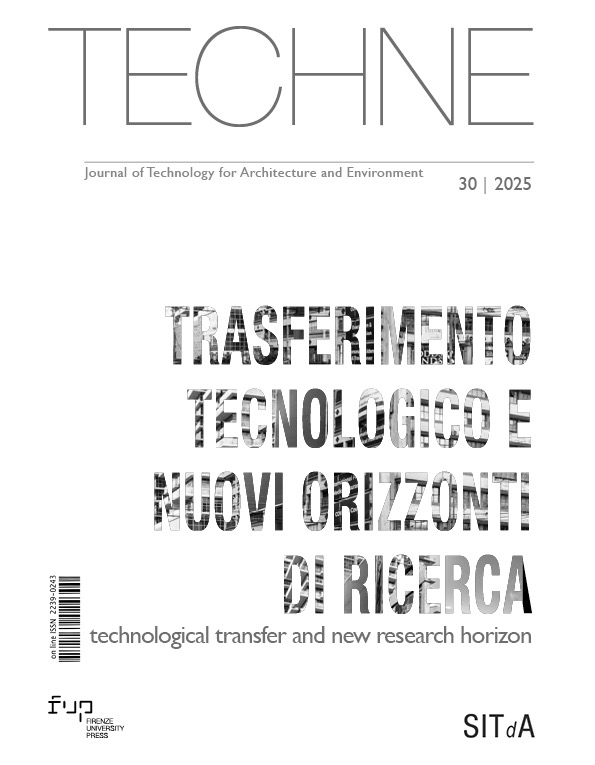Published 2025-11-07
Keywords
- Technology transfer,
- Innovation hub,
- Urban development
How to Cite
Copyright (c) 2025 Roberto Vona, Nadia Di Paola, Silvia Cosimato

This work is licensed under a Creative Commons Attribution 4.0 International License.
Abstract
This contribution explores the role of technology transfer in urban innovation development, focusing on the contribution of institutional, academic, and industrial actors. Adopting the perspective of the Triple Helix, this paper analyses the collaborative dynamics that generate innovations dedicated to the management and use of urban areas. According to an evolutionary perspective and the perspective of the Quadruple Helix, this study also emphasises the importance of citizen participation in a co-creative context within the so-called collaborative networks that promote innovation, well-being, and the sustainability of urban spaces, which stem from the synergistic and collaborative activity of institutional, academic, industrial, and social actors.
Downloads
References
- Baglieri, D., Baldi, F. and Tucci, C.L. (2018), “University technology transfer office business models: One size does not fit all”, Technovation, Vol. 76, pp. 51-63. Available at: https://doi.org/10.1016/j.technovation.2018.05.003 DOI: https://doi.org/10.1016/j.technovation.2018.05.003
- Bragaglia, F. (2024), “The University and the Neighbourhood – Opportunities and Limits in Promoting Social Innovation: The Case of AuroraLAB in Turin”, Sustainability, Vol.16, n. 2, p. 829. Available at: https://doi.org/10.3390/su16020829 DOI: https://doi.org/10.3390/su16020829
- Byers, T.H., Dorf, R.C., Nelson, A.J. and Vona, R. (2011), Technology Ventures. Management dell’imprenditorialità e dell’innovazione, McGraw-Hill.
- Capra, F. and Luisi, P.L. (2014), The systems view of life: A unifying vision, Cambridge University Press. DOI: https://doi.org/10.1017/CBO9780511895555
- Carayannis, E.G. and Campbell, D.F. (2009), “Mode 3’and’Quadruple Helix’: toward a 21st century fractal innovation ecosystem”, International journal of technology management, Vol. 46, pp. 201-234. Available at: https://doi.org/10.1504/IJTM.2009.023374 DOI: https://doi.org/10.1504/IJTM.2009.023374
- Chesbrough, H. (2017), “The future of open innovation: The future of open innovation is more extensive, more collaborative, and more engaged with a wider variety of participants”, Research-Technology Management, Vol. 60, n. 1, pp.35-38. Available at: https://doi.org/10.1080/08956308.2017.1255054 DOI: https://doi.org/10.1080/08956308.2017.1255054
- Di Paola, N., Cosimato, S. and Vona, R. (2024), “Digital social innovation: how healthcare ecosystems face Covid-19 challenges”, Technology Analysis & Strategic Management, Vol. 36, n. 8, pp.1763-1778. Available at: https://doi.org/10.1080/09537325.2022.2111117 DOI: https://doi.org/10.1080/09537325.2022.2111117
- Di Paola, N., Meglio, O. and Vona, R. (2023), “Entrepreneurship education in entrepreneurship laboratories”, The International Journal of Management Education, Vol. 21, n. 2, p.100793. Available at: https://doi.org/10.1016/j.ijme.2023.100793 DOI: https://doi.org/10.1016/j.ijme.2023.100793
- Etzkowitz, H. and Leydesdorff, L. (2000), “The dynamics of innovation: from National Systems and “Mode 2” to a Triple Helix of university–industry–government relations”, Research policy, Vol. 29, n. 2, pp.109-123. Available at: https://doi.org/10.1016/S0048-7333(99)00055-4 DOI: https://doi.org/10.1016/S0048-7333(99)00055-4
- Houari, F.E. and Fakhreddine, M.O.I. (2024), “Determinants of knowledge transfer activities among university researchers: a systematic review”, Journal of Science and Technology Policy Management, ahead-of-print(ahead-of-print).
- Kuzior, A., and Kuzior, P. (2020), “The Quadruple Helix Model as a Smart City Design Principle”, Virtual Economics, Vol.3, n.1, pp.39-57. Available at: https://doi.org/10.34021/ve.2020.03.01(2) DOI: https://doi.org/10.34021/ve.2020.03.01(2)
- Li, Z., Chen, H. and Mo, B. (2023), “Can digital finance promote urban innovation? Evidence from China”, Borsa Istanbul Review, Vol.23, n.2, pp.285-296. Available at: https://doi.org/10.1016/j.bir.2022.10.006 DOI: https://doi.org/10.1016/j.bir.2022.10.006
- Marchesani, F. and Ceci, F. (2025), “A quadruple helix view on smart city: Exploring the effect of internal and external open innovation on public services digitalization”, Technovation, Vol. 139, p.103141. Available at: https://doi.org/10.1016/j.technovation.2024.103141 DOI: https://doi.org/10.1016/j.technovation.2024.103141
- Nonaka, L., Takeuchi, H., and Umemoto, K. (1996), “A theory of organizational knowledge creation”, International Journal of Technology Management, Vol.11, pp.833-845. Available at: https://doi.org/10.1504/IJTM.1996.025472
- Vona, R., Di Paola, N., and Caroppo, L. (2015), “Technology venturing and universities: A key driver for sustainable development” in 2015 AEIT International Annual Conference, pp. 1-6. IEEE. DOI: https://doi.org/10.1109/AEIT.2015.7415225






